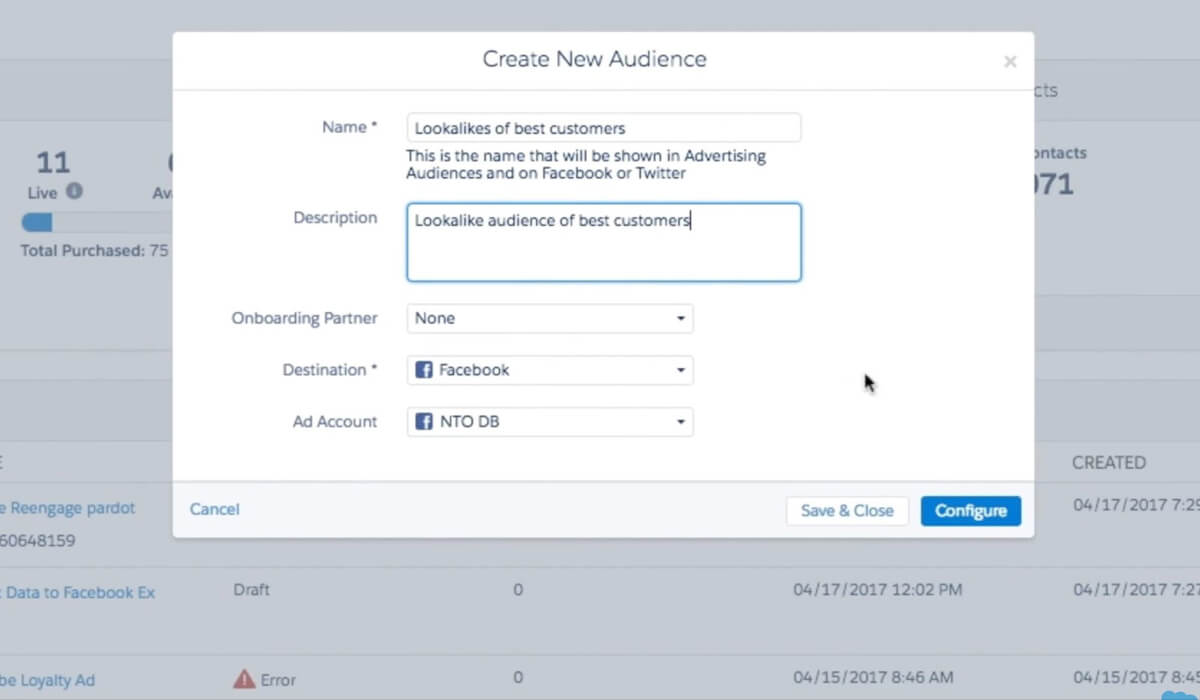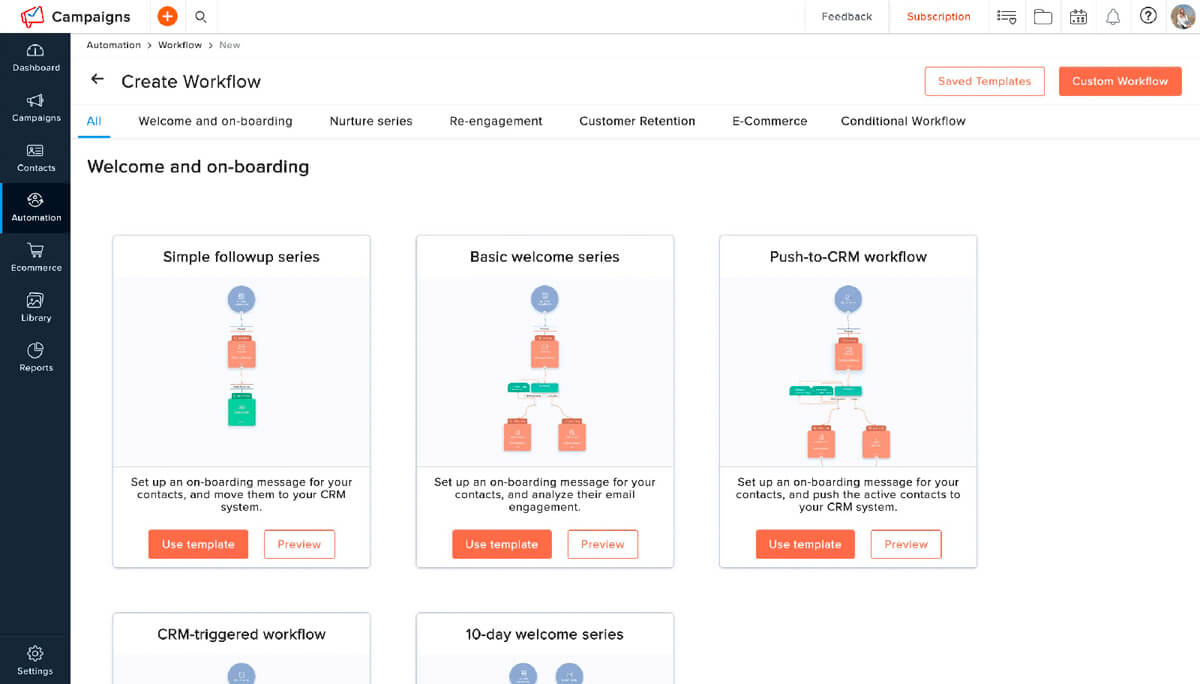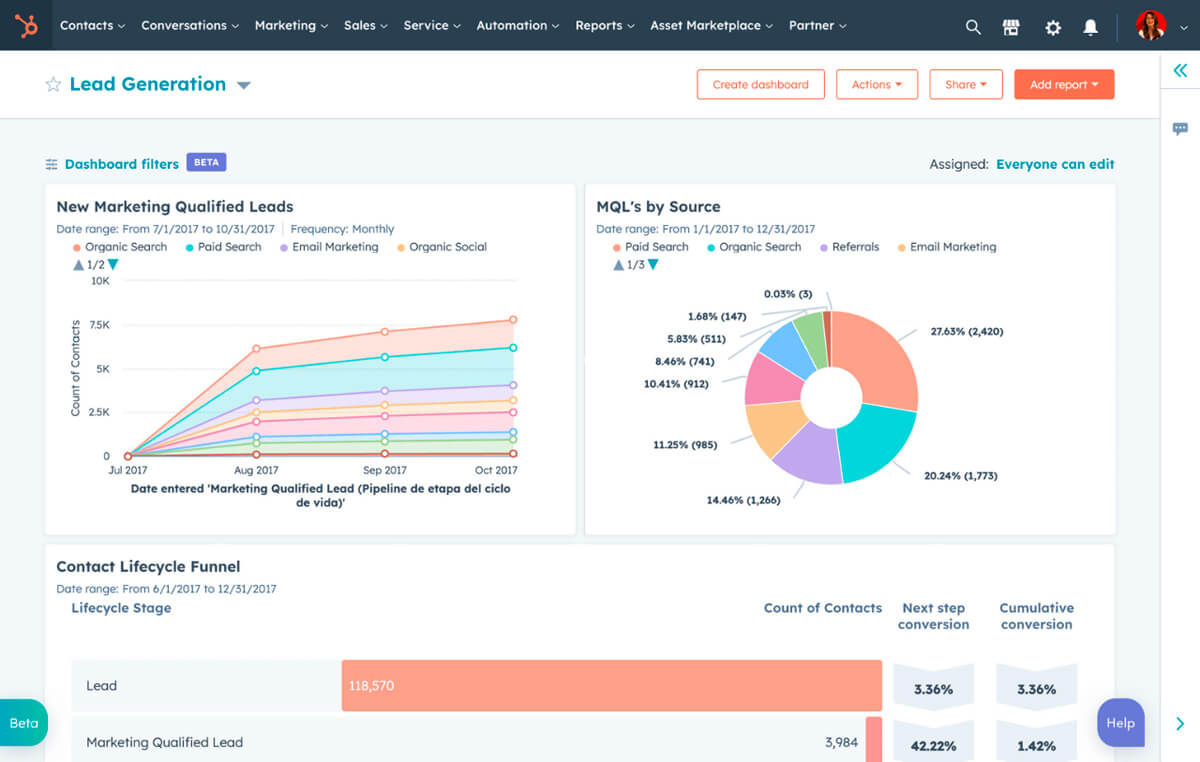-
News & Trends -
Sales -
Marketing Related Topics -
B2B Software Guides Related Topics -
Free Tools & Resources -
- About Us About Us


CRM advertising is a method of linking the data gathered by your CRM with your paid social media platforms and other advertising networks in order to create personalized messaging across different customer touchpoints. Leveraging CRM datasets in your advertising can help you ensure the prospective customer’s initial engagement leads along the path to conversion, giving you the info you need to craft a holistic and tailored experience across all interactions.
Salespeople and marketers that use CRM advertising start by collecting data on their customer interactions and demographics using CRM software that offers features such as email and social media integrations, web analytics, automations, and revenue tracking. They then segment customers into specific groups and serve these segments with personalized advertising content through various marketing channels.
Once an ad is live, it’s displayed to the target audience and its performance can be monitored via your CRM. When someone clicks on the ad, the information collected, such as website interaction and conversion data, is also tracked in the CRM.
The basic process of CRM advertising is as follows:
By following these phases, you can set up effective advertising campaigns and harvest further data for customer retention and analytics, enabling you to more easily adapt to the behaviors of your target audience. Throughout this process, also identify patterns, preferences, and pain points to refine your strategy further. For example, if data in your CRM reveals that a specific type of content or messaging resonates more with your target audience, prioritize and expand upon that approach.
There are a range of benefits that come with well-executed CRM advertising. These not only stem from the diverse pool of data available for later advertising decisions, but also from developing an efficient and centralized way of managing your advertising campaigns.
The benefits to investing in CRM advertising can have huge rewards on the impact of your upcoming advertising campaigns and how you define your future advertising strategy in the long run. Among the advantages are the opportunity to personalize the ad experience for your customers, achieve higher engagement from them, attract more qualified leads, use your budget more efficiently, and help streamline your internal operation.
A CRM advertising campaign begins with leveraging customer information for effective ad creativity and targeting. It can collect further details about the people interacting with your brand and what they like throughout the multiple touchpoints of a campaign.
Personalizing your campaigns with CRM helps to extract key insights about your target market that can inform future decisions in your advertising strategy. In the course of a CRM advertising campaign, harvest important details such as your customers’ key demographics, their behavior when interacting with your brand in the past, how far they make it through your sales funnel, and the average monetary value of their orders if and when they make purchases.
In the same vein, engagement and conversion increase significantly when advertising content is personalized to the customer. Equipped with the right datasets, you’ll be able to build an experience that delights your customers from their initial ad impression all the way to conversion.
By fully utilizing your CRM and advertising resources in tandem, you can eliminate irrelevant ads and ensure that people in your audience segments only see content that’s best suited to drive engagement.
Ensuring quality in your lead generation efforts can be a real challenge as a sales professional, but adopting CRM advertising techniques can help you target more qualified leads by giving you access to quality, diverse datasets. Combining your advertising practices and CRM software allows for more detailed behavior and event tracking, producing data that can feed into useful lead scoring models.
In many cases, these lead scoring models assign points based on contact behaviors. Clicking through to a landing page can be assigned a certain number of points, whereas downloading a lead magnet can be assigned a higher number; regardless of the interaction and point value, it can all be tracked in your CRM. When a lead accumulates a certain score, this can qualify them as a lead who is ready for further outreach and engagement.
CRM software can help you optimize your ad budget, targeting ads more specifically at the individuals who are most likely to be impacted by that content. In many cases, you can also use your CRM to track spending across channels in a more unified way. These features make CRM advertising a cost-effective way to make informed decisions about your advertising strategy.
Successful CRM advertising requires close collaboration across sales and marketing teams. By using your CRM as a staple of your advertising strategy, you’ll ensure that sales, marketing, and any auxiliary areas of your business all have access to the same data.
This model helps to facilitate more effective internal communication and teamwork, ensuring greater efficiency within your organization and departments that are able to support each other’s goals. CRMs can provide unified data access for all relevant departments and teams, allowing all stakeholders to collaborate in real-time feedback loops. Most significantly, the real-time feedback loops from your sales team on the quality of leads generated will inform future enhancements to your CRM advertising strategies.
There are practical methods of leveraging your CRM for advertising and experiencing these benefits, ensuring that your campaigns feature high-quality content and reach the right audience for maximum impact.
Some of the most effective ways to use your CRM for advertising include taking advantage of lookalike customer personas, marketing automation, and analytics. The quality of content used in social media advertising, mobile advertising, and paid search is a big part of advertising success, but showing the right content to the right people is essential to making sure your campaigns reach their maximum conversion potential.
A great way to take advantage of your CRM’s features and capabilities is to create lookalike audiences from previous data gathered through your social media advertising platform’s pixel or another tag embedded on your site. These pixels can be useful for leveraging your CRM data to improve the accuracy of your targeting, as the data you gather is from direct customer interactions rather than third-party cookies.
Aside from this, using your CRM data in advertising will allow you to create audiences based on segments that social advertising analytics aren’t able to pick up. This might include site behavior data older than 180 days (the typical maximum lifespan of pixel audiences), customers who found you through offline channels, and customer parameters you might set using your CRM data like customer lifetime value, average order value, and cost of retention.
Utilizing lookalike audiences with your best possible data can help align advertising campaigns more closely with your ideal customers and work wonders for your advertising cost per acquisition.

The wealth of data available through your CRM can help you set up useful automation rules to improve campaign efficiencies and align sales and marketing within your organization. Review the audience segments you’ve created and align rules and automation workflows with the people within your audience for whom the rule is most relevant.
For example, if you've identified an audience segment within your CRM data that shows a high engagement with content related to a specific function of your product, such as a video editing feature, you can set automation rules that target this segment with this specific kind of content in the future. Leveraging this insight may involve creating a trigger within your CRM that activates when a lead visits a how-to guide for video editing on your website, for example.
This trigger, driven by your CRM automation, can initiate an automated advertising campaign with highly specific content; the ad creatives for this campaign will be exclusively tailored to the topic of video editing, showcasing the benefits and features of this function. By delivering content that aligns precisely with your audience's actions, the chances of capturing their engagement with each impression significantly improve.
You can eventually refine your campaigns with further conditions — such as for leads showing engagement within a specific time frame or achieving a certain lead score — to enhance your automation and improve cost efficiency for your budget.

For better results and deeper insights, use CRM data to complement the insights gleaned from your advertising platforms to inform your future campaigns and achieve a healthier ROI. The most useful CRM datasets worth integrating into your advertising platform include those related to conversion attribution, cost per acquisition (CPA), customer acquisition cost (CAC), lifetime value (LTV), and churn rate analysis.
Let’s look at each one in detail:

These cover just a few of the use cases where CRM features can work hand in hand with advertising. When combined with the right CRM, you’ll soon be able to optimize your advertising campaigns and improve outcomes across your paid marketing projects.
The various features of a CRM can be applied to markedly different advertising tasks, including ad creation, performance analysis, predictive analysis, and more. Some of the top CRM software that can help you with advertising include Zoho CRM, HubSpot CRM, and Salesforce Marketing Cloud. Each software solution includes different features, strengths, and weaknesses that may make them better or worse for your unique advertising practices.
Now that we’ve seen how CRMs and ad platforms can work together, here’s a look at some of the best CRM software for advertising.
Zoho CRM is marketing software that provides a wealth of audience tracking and segmentation tools to build a clearer picture of lead behavior to inform advertising campaigns. Zoho can gather data from site forms, generate personalized promotions for individual customers, and automate email list management with user behavior rules. It also features a built-in Google Ads integration, allowing you to see ad campaigns as part of the sales process in your CRM.
Zoho CRM offers a free version that comes with standard reporting but is limited to three users. If you’re looking for more flexibility in terms of automation, custom reporting, and integrations with other tools, it’s worth considering the paid plans, which start at $14 per user, per month for a Standard plan.
Any one of these CRMs will equip you with the tools to start building advertising campaigns. However, it’s important to still keep in mind your specific requirements and goals for your unique campaign. More specifically, you should inform your strategy with detailed insights into your audience and ensure you fully understand which software will help you overcome some of the biggest challenges associated with combining your CRM and advertising.
For more information on these CRMs plus other top options, check out our buyer's guide to the best CRM software. In the guide, you'll find their pricing, key features, pros and cons, and more.
Understanding the challenges of CRM advertising will further inform your choice when selecting the most suitable software for your advertising channels. However, there are many pitfalls you may encounter as you try to make CRM advertising a working part of your marketing strategy. Here are some of the key challenges of CRM advertising you may face, as well as some advice on how to overcome them.
When customer data can enter your CRM through a variety of different touchpoints, you run the risk of working with data that’s incomplete, inaccurate, or somehow unusable in other ways. Ensuring the quality of your data is essential for running CRM-informed ad campaigns that perform as intended, so keep this top of mind as you work to optimize your campaigns.
Regularly scheduled data audits are an effective way to identify and fix any inaccuracies, duplicate data, and other issues that might undermine data quality in your CRM, ensuring you have reliable advertising audiences to work with.
When you first start to integrate advertising data with your CRM, you may find that the variety of different touchpoints your data is sourced from leads to a complex mesh of datasets that makes it hard to calculate ROI accurately.
To make the relationship between advertising and CRM data seamless, build and incorporate sophisticated attribution models into your CRM software. These models use the CRM’s customer journey mapping to assign credit to different touchpoints, including ad clicks, and create an accurate and reliable view of conversions that can be attributed to your ad campaigns.
CRM advertising may require you to manage campaigns running across several different channels. It is often further complicated when you need to leverage and analyze findings from email, organic, and other marketing spheres to inform your paid campaigns.
To make your CRM advertising as effective as possible, you’ll need to consolidate these datasets into a more comprehensive view to support analysis and campaign decision-making. Ensuring your CRM dashboard is set up to track interactions across touchpoints and using Urchin Tracking Module (UTM) tracking to monitor campaigns across different ad platforms will simplify the challenge of multichannel analysis without diluting your ad data.
Ad fatigue occurs when the same ad content is repeatedly displayed to your audience, leading to a drop in engagement. This is a challenge with any kind of advertising and should warrant serious consideration as part of your CRM advertising strategy.
To effectively avoid ad fatigue, your approach to CRM advertising should include an ad rotation strategy informed by your data, ensuring that a healthy spread of variations is shown to your audience instead of the same content over and over again. To achieve effective ad rotation, use CRM data to create personalized ad content, identify peak times when your leads are most likely to engage in ads, and schedule campaigns accordingly.
Familiarizing yourself with the potential challenges ahead as you start to engage with CRM advertising is crucial to making sure the integration serves your goals well and your strategy accounts for potential pitfalls and ways to work around them.
With the right approach, CRM advertising can give you a detailed view of who your audience is, how they’re interacting with your brand, and how to use these insights to craft more profitable ad campaigns. Adopting a data-driven approach to advertising that uses CRM software provides marketing teams with a more holistic marketing strategy — not to mention a unified advertising management platform — that will increase ROI for your advertising campaigns.
If you’d like to know more about how to optimize your online advertising, check out our article on quality PPC lead generation.


Daniel Groves is a UK-based contributing writer for Selling Signals whose specialties include sustainable growth strategies, technology trends, and business software such as CRMs. Daniel is also a business coach who helps small and large organizations improve their inbound lead generation, and he enjoys developing his knowledge and sharing his experience with like-minded entrepreneurs and business owners. In his spare time, Daniel is a big gamer and takes his two-year-old sausage dog for long countryside walks on weekends.

Selling Signals delivers actionable advice for sales and marketing professionals. Learn strategies that help you hit targets, strengthen customer relationships, and win more business. Get expert advice on lead generation, sales processes, CRM software, sales management, and account management directly to your inbox.
Property of TechnologyAdvice. © 2025 TechnologyAdvice. All Rights Reserved
Advertiser Disclosure: Some of the products that appear on this site are from companies from which TechnologyAdvice receives compensation. This compensation may impact how and where products appear on this site including, for example, the order in which they appear. TechnologyAdvice does not include all companies or all types of products available in the marketplace.